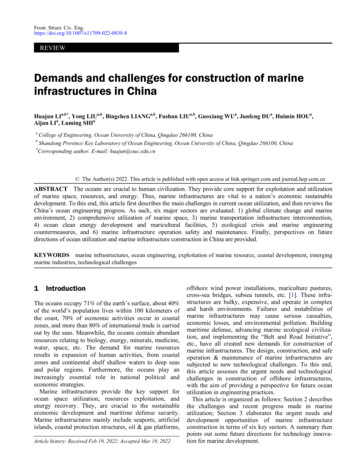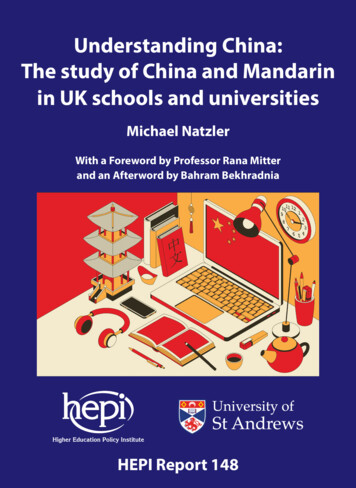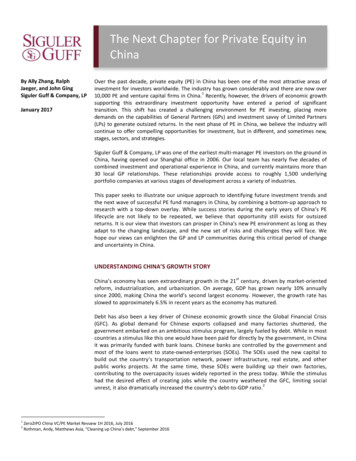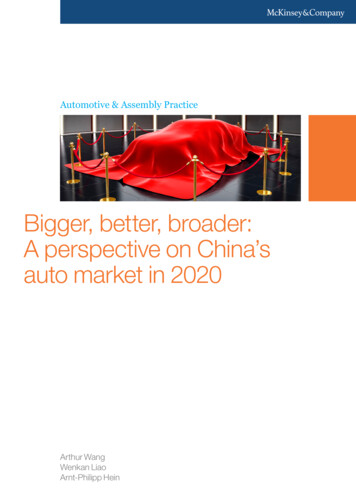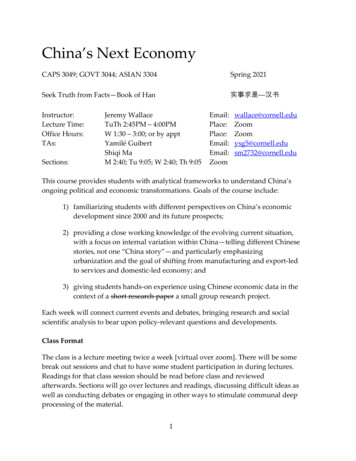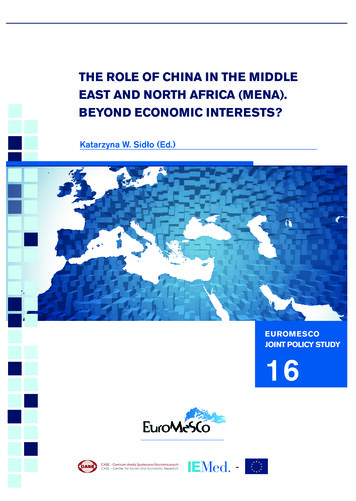
Transcription
THE ROLE OF CHINA IN THE MIDDLEEAST AND NORTH AFRICA (MENA).BEYOND ECONOMIC INTERESTS?Katarzyna W. Sidło (Ed.)EUROMESCOJOINT POLICY STUDY16
IEMed.European Institute of the MediterraneanConsortium formed by:Ministry of Foreign Affairs and CooperationGovernment of CataloniaBarcelona City CouncilBoard of Trustees - Business Council:Partner InstitutionsCorporate SponsorsCaixa BankCambra de Comerç de BarcelonaPort de TarragonaESADEBanc SabadellFoment de Treball NacionalIberiaIESE Business SchoolPort de BarcelonaPIMECSocietat Econòmica Barcelonesa d’Amics del País (SEBAP)JOINT POLICY STUDYPublished by the European Institute of the MediterraneanReviewer: Bichara KhaderEditorial team: Lucas MedranoProof-reading: Neil CharltonLayout: Núria EsparzaPrint ISSN: 2462-4500Digital ISSN: 2462-4519July 2020This publication has been produced with the assistance of the European Union. The contents of this publication are the soleresponsibility of the authors and can in no way be taken to reflect the views of the European Union or the European Institute ofthe Mediterranean.
The coordinator of the group would like tothank the participants of the DialogueWorkshop held in Warsaw on Decemberthe 3rd 2019, the reviewer, Prof. BicharaKhader, the IEMed for supporting projectimplementation and the European Unionfor co-financing the project.
CONTENTS
The Role of China in the Middle East and NorthAfrica (MENA). Beyond Economic Interests?FOREWORD. Katarzyna W. Sidło6CHINA-MENA RELATIONS IN THE CONTEXT OF CHINESE GLOBALSTRATEGY. Lars Erslev Andersen, Camille Lons, Tamás Peragovics, ErzsébetN. Rózsa, Katarzyna W. Sidło10CHINA’S ECONOMIC ENGAGEMENT IN THE MENA REGION.Katarzyna W. Sidło32CHINA’S POLITICAL, MILITARY AND CULTURAL ENGAGEMENT INTHE MENA REGION. Erzsébet N. Rózsa, Tamás Peragovics58THE GEOPOLITICAL IMPLICATIONS OF CHINA’S PRESENCE IN THEMENA REGION. Lars Erslev Andersen, Camille Lons88ANNEXES109
ForewordKatarzyna W. Sidło** Director of the Middle East and North Africa Department, CASE – Center for Social and Economic Research
The Role of China in the Middle East and North Africa (MENA). Beyond Economic Interests?China is a relative newcomer to the Middle East and North Africa (MENA) region. Indeed,as it is not in China’s immediate neighbourhood, for a long time its importance to Beijingremained low. This began to change in the early 2000s. Due to its impressive economicexpansion, marked by joining the World Trade Organization in 2001, China’s energyconsumption growth rate accelerated, making the energy-rich region increasingly crucialto China’s energy security. Thus, the destabilization that came to the MENA with theGlobal War on Terror declared by the United States as a result of the 9/11 terroristattack, endangered its interests. At the same time, however, having significant Muslimminorities of its own, China was keen to maintain the security of its Muslim-majorityprovinces and used the GWOT as justification for curbing the threat of its internal,separatist “Islamic terrorism”. Eventually, then, to accommodate its growing interest inthe region, China expanded its “greater neighbourhood” to include the MENA as well(currently, a good part of Europe has also been declared a part of it). Presently, whilestill not a key partner for Beijing, the region is one of the main suppliers of China’s gasand oil, an increasingly important export destination, a territory of continuous constructionactivity of Chinese companies under the Belt and Road Initiative (BRI), and an object ofa large-scale Chinese charm offensive. Slowly, it is becoming an object of Beijing’ssecurity interests as well.Against this background, in this Joint Policy Study (JPS) we analyse the relationshipbetween China and the MENA countries from an economic and socio-political point ofview. We explore how this relationship has changed over time and whether and to whatextent it has evolved since the launch of the BRI in 2013. At the same time, we try tounderstand what implications the increased Chinese presence in the MENA region hashad for its countries, but also for the European Union (EU) and its allies. Finally, wheneverpossible, we make predictions as to the future development of the China-MENA ties.At this point it is essential to mention that this study was finalised at the beginning of2020 and prepared for print in March 2020, when the coronavirus (Covid-19) pandemichave already had a profound impact on several countries around the world, leaving1 This designation shall not be construed as recognition of a State of Palestine and is without prejudice to the individual positionsof EU member states on this issue.7 JOINT POLICY STUDYFor the sake of accuracy, it must be underlined here that what is usually understood inEurope as the Middle East and North Africa (Algeria, Bahrain, Egypt, Iran, Iraq, Israel,Jordan, Kuwait, Lebanon, Libya, Mauritania, Morocco, Oman, Palestine1, Qatar, SaudiArabia, Sudan, Syria, Tunisia, Turkey and the United Arab Emirates [UAE]) the Chinesecall Western Asia and North Africa. However, in the name of convenience and coherence,in this study, we shall use the well-established acronym MENA to indicate the abovelisted countries.
The Role of China in the Middle East and North Africa (MENA). Beyond Economic Interests?8 JOINT POLICY STUDYthousands of people dead and millions more affected. China was the first country inwhich the virus was reported and for the first quarter of the year remained an epicentreof the pandemic. In February 2020, the first cases were reported in Iran, one of the moreheavily affected countries so far. By March, every single country in the region had beenaffected. The pandemic will have an impact on the economic performance of the countriesunder study and the livelihoods of their citizens – as well as their relationship with each other– in ways difficult to predict as yet. Depending on the length of the lockdowns imposed bythe national authorities, the stimulus packages approved and the level of cooperationbetween individual countries, the economic crisis that will ensue may take more or lesssevere forms. Beyond economics, the very world order as we know it is under threat, withthe pandemic already predicted by some to be the straw that may break the globalisationcamel’s back. China, accused of exacerbating the threat by initially concealing the outbreakof the coronavirus disease, has embarked on a public relations campaign to portray itself asa saviour rather than a culprit (concurrently reviving its “Health Silk Road”). Over the pastweeks, Beijing has been very publicly sending planes full of medical equipment, masks andmedical staff to countries around the world, including the United States (US) and the EUmember states. Reports of Washington allegedly hijacking masks and other key suppliesbound for its allies (which the US administration vehemently denies) and the EU countriesrestricting exports of ventilators (condemned by Brussels) make winning this propagandawar much easier for Beijing. In the MENA region, China has already announced deliveringthousands of coronavirus test kits and other equipment needed to fight the pandemic(although Turkey, for instance, rejected the tests due to their inaccuracy and it is not clearin all cases whether the recipient countries purchased or were gifted the equipment).Simultaneously, another crisis of relevance to our study has been taking place in the firstquarter of 2020: the oil price war between Saudi Arabia and Russia, which drove the priceof Brent Crude down to USD 16 (indeed, the price of oil briefly turned negative in April2020). Needless to say, a considerable decline in demand in one of the leading buyers,China, as well as other countries due to the coronavirus pandemic, further aggravated thesituation in the energy market. Significantly lower revenues from oil sales will have an adverseimpact not only on the economies of the oil-exporting countries but also on other statesthroughout the region that rely on financial support and remittances from the Gulf.Every research project needs to stick to its designed timeframe, however. Otherwise, itwould never be completed but rather updated to infinity. As such, the aforementionedcrises were not taken into consideration while producing the analysis, which was almostentirely finalised by the end of January 2020. Future, follow-up studies will no doubtaddress those.
The Role of China in the Middle East and North Africa (MENA). Beyond Economic Interests?Accordingly, Chapter 1, compiled collaboratively by all the authors of the JPS, sets thecontext for the entire study. In it, the authors explore Chinese engagement in the MENAregion from a historical perspective and against the background of Beijing’s rise to thestatus of global power. They take a closer look at BRI, a flagship project of ChinesePresident Xi Jinping, and trace the history of the diplomatic and otherwise relationshipbetween China and individual countries in the MENA region starting from 1949, whenthe People’s Republic of China was proclaimed, until now. Finally, they analyse theattitudes of the political elites and citizens of the MENA countries towards China’sgrowing presence in their region.In the second Chapter, Katarzyna W. Sidło from CASE – Center for Social and EconomicResearch examines the economic relationship between China and the MENA states.She takes a look at the growing volume of trade exchange between the two and varioustypes of Chinese official finance flowing to the countries in the region: from investment,through loans, to developmental aid. She also uncovers the characteristics of theactivities of Chinese companies in various countries under study. The final section of herChapter is dedicated to an analysis of the implications of Chinese economic presencein the MENA region for the EU.Finally, in the fourth Chapter, Lars Erslev Andersen from the Danish Institute forInternational Studies (DIIS) and Camille Lons from the International Institute for StrategicStudies (IISS) look at the geopolitical implications of China’s presence in the MENAregion. Against the background of the US’ (perceived) withdrawal from and increasingmultipolarity in the region, they analyse China’s strategy for its presence in individualcountries and the MENA region as a whole. They conclude by assessing the implicationsof Beijing’s growing involvement across the region for its stability and prosperity, as wellas for its relationship with the EU.9 JOINT POLICY STUDYChapter 3, prepared by Erzsébet N. Rózsa from the Institute of World Economics inthe Centre for Economic and Regional Studies and Tamás Peragovics from CentralEuropean University and the Institute of World Economics, unravels the complexrelationship between China and the MENA region, focusing on Beijing’s political,military and cultural engagements. They assess the depth and breadth of China’sinvolvement in conflict mediation and peacekeeping missions in the MENA region,showcasing Beijing’s delicate balancing act between maintaining a cordial relationshipwith various clashing powers in the region, from Saudi Arabia, through Iran, to Israel.Additionally, they explore the scale of China’s cultural engagement and soft powerbuilding across the region.
China-MENA Relations in the Context of ChineseGlobal StrategyLars Erslev Andersen*, Camille Lons**, Tamás Peragovics***,Erzsébet N. Rózsa****, Katarzyna W. Sidło****** Senior Researcher, DIIS - Danish Institute for International Studies** Research Associate, IISS - International Institute for Strategic Studies*** PhD candidate at the Department of International Relations of Central European University; External Lecturer, European Studies Department, ELTE University**** Senior Research Fellow, Institute of World Economics***** Director of the Middle East and North Africa Department, CASE – Center for Social and Economic Research
The Role of China in the Middle East and North Africa (MENA). Beyond Economic Interests?China’s Relationship with the Middle East and North AfricanCountries – A Historical PerspectiveHistorically, the states of the Middle East and North Africa (MENA) region have featuredon China’s (back then – the People’s Republic of China) geopolitical compass fordifferent reasons. Nevertheless, there are certain general ideological underlying basesthat to this day have been guiding the selection of partners: the non-aligned status,communist internationalism, and, finally, economic considerations.Following the death of Mao Zedong in 1976, the new Chinese leadership under DengXiaoping adopted a novel approach to foreign policy (Vogel & Ezra, 2011). Ratherthan pursuing revolutionary aims in external affairs, Deng sought to normalise ties withother countries and open up China to the rest of the world, primarily by creatingspecial economic zones and inviting foreign capital to them. Coming after twodecades of disastrous economic and social policies, chief among them the GreatLeap Forward between 1958 and 1962, the reform and opening of the 1980s thusled to an era of unparalleled economic growth. It also inaugurated a new, practicaland instrumental approach in external affairs that appreciated the potential role offoreign partners in China’s long modernisation process.11 JOINT POLICY STUDYDuring the Cold War, after the proclamation of the People’s Republic of China in1949, the Non-Aligned Movement (NAM) provided the context of Chinese relationswith like-minded Middle Eastern states. After the 1955 Bandung Conference inIndonesia, the mutual respect for sovereignty and territorial integrity, mutual nonaggression, non-interference in each other’s internal affairs, equality and mutualbenefit, and peaceful coexistence (known as the Five Principles of PeacefulCoexistence [Ministry of Foreign Affairs of the People’s Republic of China, 2014])provided the basic pillars of the friendly relationship between China and the nonaligned MENA states – Algeria, Egypt, Iraq, Jordan, Kuwait, Lebanon, Libya, Morocco,Syria, Sudan and Tunisia, all of which joined the NAM in the 1960s (later, other Arabcountries and the Palestinians also joined) (Haddad-Fonda, 2015). In 1956, Egyptwas the first Arab country to recognise China’s communist government primarily forits “neutrality” (followed by Syria, North Yemen, Iraq, Morocco, Algeria and Sudan inthe same year). The five principles of peaceful coexistence have remained relevant tothis day: these provide not only the political cornerstone of the relationship, and acommon front from which Western interventions are regularly criticised and opposed,but also are essential elements in the Chinese self-perception of the responsiblesuperpower.
The Role of China in the Middle East and North Africa (MENA). Beyond Economic Interests?This foreign policy reassessment under Deng Xiaoping also introduced a new elementto the Chinese perception of the MENA states and a new point of selection, namely theeconomic “usefulness” of the selected states. As the country witnessed unprecedentedeconomic growth during that period, it became a top priority for the Beijing governmentto secure stable oil supplies for its domestic economy (Besada & Salam, 2017).Consequently, Chinese foreign policy has been characterised by a transactionalapproach, illustrated by a plethora of economic agreements.Presently, China’s relations with the MENA states continue to expand, and a number ofkey factors explain why this is expected to continue. The most important is the economicone. The MENA region is of specific importance to China as an area rich in energyresources needed to sustain the growth in China, offering vast opportunities forsubstantial infrastructure investments in ports, railways and highways, as well as innuclear energy and high-tech development. Besides the continued (although slowlydiminishing) reliance on MENA oil, the non-oil exporting countries of North Africa areincreasingly serving as export markets for Beijing. Moreover, countries in the Persian Gulf(as well as Egypt) are strategically placed on the trade route to Africa and Europe.China’s Global Expansion and the Belt and Road Initiative12 JOINT POLICY STUDYBefore exploring China’s modern relationship with the MENA states any further, it is vitalto take a step back and examine the broader context within which it developed, namelyChinese President Xi Jinping’s flagship foreign and economic policy project, the Beltand Road Initiative (BRI, previously One Belt One Road or OBOR), also called the SilkRoad Economic Belt (SREB) and the 21st-century Maritime Silk Road (MSR) initiative.First presented by Xi in September 2013, the initiative is a series of hard and softinfrastructure projects intended to revive the ancient Silk Road to connect China andEurope. The “belt” – or SREB – is a land route linking China to Europe through CentralAsia and the Middle East while the “road” – or MSR – is a maritime route linking SouthChina to the Mediterranean through the Indian Ocean and the Suez Canal. Together,they have been dubbed by some commentators the “Chinese Marshall Plan”, as it wasmainly envisioned to develop the Eurasian continent, but the geography of the BRI hasdeveloped to be open to all nations.The original Silk Road was established around 140 BCE during Han Dynasty anddeveloped as China’s westward economic expansion during the first millennium BC.
The Role of China in the Middle East and North Africa (MENA). Beyond Economic Interests?With the reforms of Deng Xiaoping in 1978, China initiated an impressive economicdevelopment that over 40 years lifted 800 million out of poverty, developed China tohave an expanded and modern infrastructure, and created big cities and agglomerations.The population of Shenzhen, for instance – the main centre for the Chinese multinationalcompanies like Huawei – rose from approximately 50,000 inhabitants in 1980 to 12million in 2020. In 1980, Shenzhen was designated a Special Economic Zone (SEZ) inorder to develop market, industry and infrastructure. The SEZ appears to be the rolemodel in the structure of the BRI with its creation of economic corridors. The successfuleconomic development has left China with a booming economy but also with surpluscapital, capacity and manpower, as well as a need to sustain economic growth andtransform the economy to become innovative and high-tech oriented. The backgroundfor the BRI is, therefore, an economic strategy to invest the surplus capacity in westwardexpansion, coupled with other motives such as improving stability through developmentfrom the Xinjiang province into Central and South Asia, establishing new trade,investment opportunities and export markets, increasing Chinese influence in the regionand beyond, as well as weakening the United States’ (US) dominance in the regionaland global economy (Cai, 2018). Finally, as an expert on China, Elizabeth Economy(2018) argued, the aim was to “shape international norms and institutions and forcefullyassert its presence on the global stage.”13 JOINT POLICY STUDYWestward it connected through Central Asia China to Europe and southward throughthe Indian subcontinent to Europe. The Roman and later the Byzantine Empires and Chinatraded goods like silk and spices from China, and gold, horses and furs from Europe,thus connecting markets along the Silk Road creating wealth as well as cultural andreligious exchange. During this period, culture and trade flourished in the area betweenthe Mediterranean and China with new cities and states established until Europe in thefirst half of the second millennium discovered new ship routes to India and colonised theAmericas while China came under pressure from the Mongols (Frankopan, 2015). Themain route went between the Mediterranean and China through Syria, Iraq, and Iran, andcontinued via Afghanistan to Xi’an in Central China. As such, MENA was an importantpart of the ancient Silk Road not only in trade and exchange of commodities but also inthe spreading of culture and religion, first Buddhism westward from China and later Islameastward from MENA, where Muslims settled (especially in the Western provinces ofChina, e.g. Uighurs in Xinjiang and Hui Muslims in the Norhtwest China). Along the route,ideas were disseminated enabling the different eastern and western civilizations tointeract and develop (Frankopan, 2015). MENA and China were also connected via amaritime route from Guanhzhou (Canton) in Southern China through Southeast Asia, theIndian Ocean to The Red Sea and Alexandria.
The Role of China in the Middle East and North Africa (MENA). Beyond Economic Interests?While the initiative is presented by the Chinese leadership as neutral and beneficial toall (Xi, 2017), it de facto aims to put China at the centre of global trade routes andprimarily focuses on advancing Chinese economic interests. Indeed, it has beenostensibly designed as an economic policy project, focused on helping Chinesecompanies to grow through overseas projects and markets, to export industrialovercapacity and to obtain strategic assets including natural resources and technology.From a foreign policy point of view, Beijing hopes that closer economic ties forgedthrough the BRI will strengthen diplomatic relations between China and the countriesalong the routes and promote multi-polar world order. From a geopolitical perspective,the BRI is a strategic countermeasure to the Barack Obama strategy “Pivot to East Asia”from 2012, which Beijing interpreted as a US attempt to contain China.14 JOINT POLICY STUDYThe structure and definition of the BRI have progressively evolved and expanded sinceXi’s announcement in 2013. In 2015, the Chinese Ministry of Foreign Affairs defined theobjectives of the BRI in its Visions and Actions on Jointly Building Silk Road EconomicBelt and 21st Century Maritime Silk Road (Xu, 2015). The paper emphasises fivepriorities: political coordination, connectivity of facilities, trade, financial integration, andpeople-to-people bonds. The same year, China hosted an Asia-Europe Meeting where itprovided more details on the structure of the BRI and announced the creation of sixeconomic corridors. As the BRI has developed to become a global project and alldifferent kinds of initiatives are put under its umbrella, it may be questioned whether thecorridors still matter. However, when analysing the economy and the initiatives prioritisedby the Chinese government, it still makes sense to focus on the activity in the corridorsas the World Bank does in its report on BRI economics (World Bank, 2019). One ofthese corridors, the China-Central West Asia Economic Corridor (CCWAEC) is mainlycentred on China’s connectivity to the Middle East (although not North Africa). In 2017,China hosted its inaugural Belt and Road Forum in Beijing, followed by a second one inApril 2019. The attendance levels show a sharp increase of participation between thetwo forums, with the number of heads of state attending going up from 29 to 36.Interestingly, among MENA states, only the United Arab Emirates (UAE) sent top-levelrepresentation to the 2019 Forum.Despite these continuous efforts to define and promote the BRI, the structure, themechanisms and the delimitation of the initiative remain extremely vague. The broad definitionof the BRI allows a wide range of projects to be included that ordinary internationaleconomic relations would have covered anyway. Indeed, Xi Jinping has underlined that theBRI is not only about infrastructure and connectivity but also investment in health andeducation financed by Silk Road funds established by China (Xi, 2017; Swaine, 2015).
The Role of China in the Middle East and North Africa (MENA). Beyond Economic Interests?Parallel to the development of the BRI, China established the Asian InfrastructureInvestment Bank (AIIB). Establishment of the AIIB was prompted by identification of amajor infrastructure gap in Asia in a report published in 2009 (ADB, 2009) by the AsianDevelopment Bank (ADB), dominated by Japan and the US. In 2015, 50 countries ledby China signed the project and the bank was established with equity of USD 100 billion,of which China injected half. However, as China researcher Yitzhak Shichor argues,economics alone cannot explain why China decided to establish the AIIB since existingnational and transnational institutions such as the ADB or the Shanghai CooperationOrganisation (SCO) already exist. For Shichor (2018), China’s objective in creating theAIIB is to bypass other organisations, which, due to being traditionally dominated by theUS and Japan, have repeatedly made China feel discriminated against, whether regardingmembership preconditions or in terms of the voting power. Not surprisingly, both the USand Japan declined the invitation to join the AIIB.At the same time, it is worth pointing out that China does attach more strategic meaningto certain parts of the BRI than to others. Notably, the China-Pakistan Economic Corridor(CPEC) and the China-Central Asia-West Asia Economic Corridor are projected to notonly contribute to regional development and stability but also provide China withalternative routes of transportation and sources of energy. Both the Central-West Asiaand CPEC corridors would reduce China’s “Malacca Dilemma”. The term was coinedby former Chinese president Hu Jintao in 2003 to refer to the situation whereby Chinarelies on the Malacca Strait for its marine transportation, while the strait can be blocked15 JOINT POLICY STUDYInitiating the BRI and establishing the AIIB is an enormous project that for itsimplementation need huge Chinese financing, maybe more than USD one trillion (Chatzky& McBride, 2020) and the question is whether China has the resources to spend somuch on the project especially if the global economy bumps into a major crisis with therisk of recession. Still, it is an impressive project that would increase China’s globaleconomic and geopolitical position and if successfully implemented it will give Chinahuge impact on regional development as well as on international institutions (Cai, 2018).As such, the BRI has inspired or maybe provoked both the European Union (EU) andthe US to develop global connectivity projects. However, the BRI and AIIB have alsomet resistance and criticisms from partners, e.g. Malaysia, which argue the costs are alltoo expensive and with the risk of a global economy in a recession these challenges tothe BRI will be increasing in the coming years (Crawford & Gordon, 2020). Further, theBRI has increasingly been met by worries in the EU that find it necessary to protect itssensitive infrastructure and outspoken criticism from the US that accuses the BRI ofbeing a Chinese strategy to obtain global hegemony.
The Role of China in the Middle East and North Africa (MENA). Beyond Economic Interests?by rival – Indian and American – navies in the event of a conflict. The planned corridorsare therefore crucial to China’s global trade and strategic interests, a necessarycomponent of Xi Jinping’s China Dream of rejuvenating the Chinese nation.The MENA Region’s Position within the BRI16 JOINT POLICY STUDYAs already mentioned, the MENA region is crucial for the development of the BRIbecause its location between the Mediterranean, the Red Sea and the Persian Gulf isimportant along the land route as well as the sea lanes and because the MENA connectsEast Asia with Eurasia and Europe (even though many countries in the region have initiallybeen excluded from the project and joined the BRI later by virtue of signingMemorandums of Understanding [MoUs]). In 2017, China became the world’s largestimporter of oil and in 2018 of gas, and is currently the biggest buyer of energy resourcesfrom the Persian Gulf. In the past decade, China’s trade volume with the Middle Easthas increased tenfold and China’s economic interests in the region match the Gulfcountries’ efforts to diversify foreign economic relations and restructure their economiesaway from a reliance on oil (for more on the economic relationship between China andthe MENA region, see Chapter 2). China and the national governments in the regionhave expressed intentions of cooperation between the BRI and the latter’s nationaldevelopment plans, such as Saudi Arabia’s Vision 2030 and Qatar’s National Vision2030.While, as already mentioned, the BRI is a strategy for China to increase its position visà-vis the US “Pivot to Asia” strategy, China acknowledges the US security hegemony inthe region and thus far has no intention to challenge it. However, with increaseddependence on energy and investments in megaprojects, trade and connectivity, as wellas interest in critical infrastructure investments – and deploying vast numbers of Chinesenationals in conjunction with the activities – a security dimension is unavoidable and willchallenge China in the coming years, as will the many conflicts in the region. Followingits traditional policy of neutrality and non-interference is, in the long run, impossible:remaining equally close to Iran and Saudi Arabia, for instance, will become increasinglychallenging for Beijing.Continently for China, its efforts to cement influence in the MENA region came at a timeof a decline of American influence in the region (or the perception thereof). After theSeptember 2001 terror attacks against the US, a series of American military interventionsfollowed that led many regional leaders to question whether Washington is a force for
The Role of China in the Middle East and North Africa (MENA). Beyond Economic Interests?good. In addition, the years following the 2003 Iraqi intervention have seen muchhesitancy and uncertainty in America’s overall approach towards the MENA region(including the already mentioned pivot to Asia by Obama and the very selectiverelationship with a very few in the region by the Trump administration), leading to theperception that Washington is no longer a solid security provider whose key objecti
At this point it is essential to mention that this study was finalised at the beginning of 2020 and prepared for print in March 2020, when the coronavirus (Covid-19) pandemic have already had a profound impact on several countries around the world, leaving 7 JOINT POLICY STUDY The Role of China in the Middle East and North Africa (MENA).





